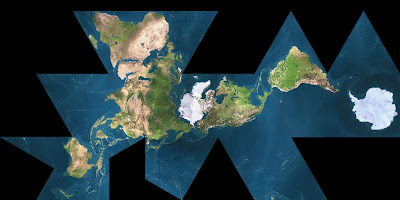
Mirage from the distorting heat of the salt pan
In the beginning of Fata Morgana, Werner Herzog shows several airplanes landing over and over again on a single runway. When each plane lands, the camera cuts to the next plane landing in the exact same manner. The more airplanes that land, the more smoggy and polluted the air becomes. Eventually there is so much exhaust in the air, the airplanes look wavy and distorted and appear to change direction, almost as though they going to run into the camera. In the essay, Singer states that this scene "graphically belie the eschatology of the creation myth that would return us full circle to a timeless beginning. Ironically, the tedium of abortive montage is our most scrupulous awareness of the ineluctable passage of historical time."
I don't quite know exactly what this statement means, but I think Singer is trying to comment on the repetitiveness of this scene and how it creates a unique idea of time instead of showing the airplanes in "real time." Time appears to be a theme in Singer's essay and he uses in many contexts without fully explaining what they mean; for example, he throws around phrases such as human time, narrative time, and historical time. How can time be different in these regards? Is narrative time simply the sequence of events in the film? Does human time refer to the experiences of the actors or the audience, or neither?
While Singer experiments with notions of time, William L. Fox's Terra Antarctica: Looking into the Emptiest Continent experiments with notion of space. Fox is interested in "how we use cultural means to augment our neurobiology in order to overcome the perceptual difficulties we experience when exploring large spaces." I especially liked the parts of the chapter where he discusses the connection between cartography and art and how they share a common and ancient visual framework.
 World map
World map
 Anne Noble, Board game produced by Shell Oil to commemorate the Hilary/Fuchs Antarctic expedition of 1957-58, 2006
Anne Noble, Board game produced by Shell Oil to commemorate the Hilary/Fuchs Antarctic expedition of 1957-58, 2006
Noble's all-white landscapes remind me of photographer Hiroshi Sugimoto's Seascapes, where sea and sky become monochromatic shades of grey.
I don't quite know exactly what this statement means, but I think Singer is trying to comment on the repetitiveness of this scene and how it creates a unique idea of time instead of showing the airplanes in "real time." Time appears to be a theme in Singer's essay and he uses in many contexts without fully explaining what they mean; for example, he throws around phrases such as human time, narrative time, and historical time. How can time be different in these regards? Is narrative time simply the sequence of events in the film? Does human time refer to the experiences of the actors or the audience, or neither?
While Singer experiments with notions of time, William L. Fox's Terra Antarctica: Looking into the Emptiest Continent experiments with notion of space. Fox is interested in "how we use cultural means to augment our neurobiology in order to overcome the perceptual difficulties we experience when exploring large spaces." I especially liked the parts of the chapter where he discusses the connection between cartography and art and how they share a common and ancient visual framework.
This reminded me of Buckminster Fuller's Dymaxion maps, where Antarctica is given full respect for being a continent instead of being chopped up at the bottom like it is in any traditional map. The grid that makes up the lines of latitude and longitude become messy when flattened into a two dimensional rectangle, causing a common map to misrepresent the big circular continent. When I was a child I never even knew Antarctica was circular, it always looked like a long white blob at the bottom of the map.
 World map
World mapPhotographer Anne Noble has studied the varying maps of Antarctica that exist in our world and in her maps series, she depicts some of these common representations of antarctic maps. Of these maps she states, "This collection of maps points to the way visual colonization of place occurs as a part of the way that we map, photograph, organize, define and interpret place." Noble shows her viewers the ways in which culture has come to know and interact with Antarctica through mapping. Anne Noble, Bung in Antarctica on a blow-up globe, 2005
Anne Noble, Bung in Antarctica on a blow-up globe, 2005
 Anne Noble, Bung in Antarctica on a blow-up globe, 2005
Anne Noble, Bung in Antarctica on a blow-up globe, 2005 Anne Noble, Board game produced by Shell Oil to commemorate the Hilary/Fuchs Antarctic expedition of 1957-58, 2006
Anne Noble, Board game produced by Shell Oil to commemorate the Hilary/Fuchs Antarctic expedition of 1957-58, 2006Besides the connections between art and cartography, Fox also mentions the visionary dissonance that occurs during whiteout conditions in the antarctic. Visible light is dispersed in a perfectly even manner and your balance and coordination is lost. Fox even mentions that many people experiencing temporary visual impairment involving hallucinations and loss of vision. Noble reflects on this disorienting feeling in her White Out series, which depicts potentially terrifying moments of a blizzard when visibility is limited to tones, textures, and layers of whiteness. Distinction between ground and sky is mostly, if not completely, eliminated. Anne Noble, White Out, 2002-2007
Anne Noble, White Out, 2002-2007
 Anne Noble, White Out, 2002-2007
Anne Noble, White Out, 2002-2007




No comments:
Post a Comment